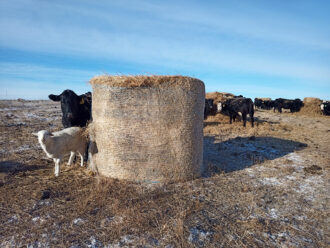The Challenge
When siblings Erin and Drew Gaugler, who grew up on a farm, decided to turn to agriculture full time as adults, they found themselves ranching on land in North Dakota that had been severely degraded from years of mismanagement by previous occupants. Farming and overgrazing had left the soil with low fertility and susceptible to wind and water erosion. The Gauglers began to rejuvenate the land with cover crops and intensive rotational grazing. They also became interested in bale grazing, or the practice of leaving hay bales in fields during the winter for livestock to graze. University research has shown that bale grazing can increase soil health and reduce winter feeding costs, but the Gauglers couldn’t find good examples of how to bale graze on a working ranch, giving them little guidance on how to move forward.
The Actions Taken
Supported by a SARE Farmer/Rancher grant, the Gauglers set up and monitored a system that involved planting multi-species cover crops and grazing them in the fall, then putting out bales for livestock to graze over the winter. Permanent and temporary fencing was used to rotate the animals and control their access to the hay, and bales were placed in areas that had especially low levels of organic matter. The Gauglers took soil samples and tracked body condition scores.
In 2020 the Gauglers received a second SARE grant to continue their evaluation of bale grazing and to integrate sheep into the system. A benefit of adding sheep is that manure is more evenly distributed across the field and soil compaction is limited. Also, cattle and sheep don’t share parasites, which helps break pest life cycles. Sheep are able to browse closer to manure deposits than cattle are, which can result in improved feeding efficiency.
While they used cover crops in conjunction with bale grazing during the first project, the Gauglers observed that bale grazing on established perennial fields was a more effective strategy to build soil health and to improve both forage production and economic sustainability.
The Impacts
While some of their work is ongoing, the Gauglers have achieved one of their primary goals: showing themselves and their neighbors that bale grazing is viable. “Folks in the local area have asked us several questions about what we are doing with the bales, and they wonder how it works,” said Erin. “Drew and I have noticed that a handful of those same people have begun to implement bale grazing on their own operation.” Other impacts include:
- Outreach to peers: Through tours, talks, podcasts, flyers and other outreach, the Gauglers reported sharing project information with 1,500 local farmers and 200 agriculture professionals.
- Farmer adoption: While the Gauglers report that 10 local farmers have changed or adopted a new practice after learning about their work with bale grazing, the impact across the region is harder to track.
The Gauglers have received several SARE grants over the years to test out new farming methods on their land. They’ll talk about their grant projects that focused on bale grazing as a way to improve soil health. By prioritizing the health of the land, they know they’ll be able to pass it down to future generations. SARE partnered with PBS KVIE to produce this special video from America's Heartland, which features farmers describing their commitment to sustainability, how they plan to meet farming challenges of today and tomorrow, and how SARE has impacted their farming and/or ranching practices.
View Related SARE Grants:
- Bale Grazing to Build Soil Health (FNC18-1123)
- Multi-Species Bale Grazing to Build Soil Health (FNC20-1218)
